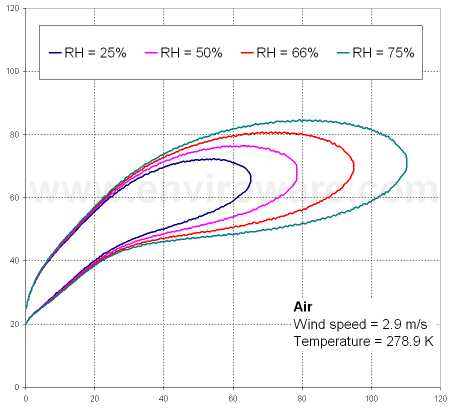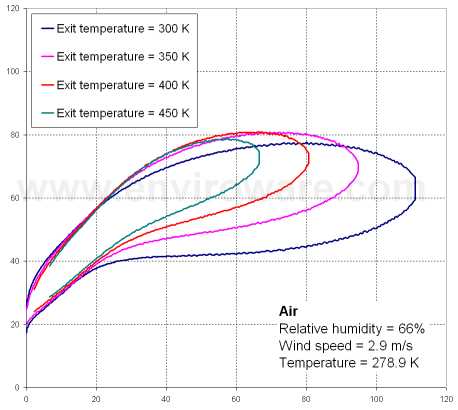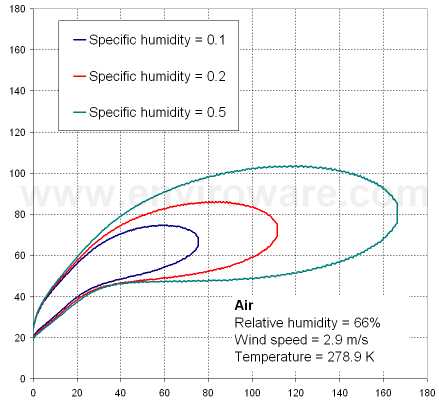Assessment of the visibility of plumes emitted by stacks
The flue gas of steam generators and boilers is characterised by values of temperature and vapour water content higher than those of the surrounding ambient air. The same is true for stacks with scrubbers and for biomass sources. The flue gas emitted by a stack moves vertically due to its initial velocity and to the thermal buoyancy, and horizontally due to the ambient wind speed.
During its motion the plume dilutes due to the entrainment of ambient air caused by wind speed and atmospheric turbulence, and eventually it reaches the values of the ambient air. The dilution process interests all the scalar properties of the plume which means, for example, the concentration of pollutants, the plume temperature and the plume moisture.
Under certain meteorological conditions plumes with high moisture levels can be visible due to the fact that the entrained ambient air decreases the plume temperature causing the condensation of water vapour. If the visible plume touches the ground, it generates plume induced fogging if the ambient temperature is positive, and plume induced icing if ambient temperature is below 0 °C.
The formation of visible plumes should be avoided if possible, or at least efforts must be done to reduce their sizes. In fact visible plumes have a series of negative effects:
- they cause concerns in the population living close to the plant boundaries;
- soluble gases within the plume (pollutants) may dissolve within the condensed water and, if the liquid water content becomes sufficiently large, some droplets may precipitate from, or rain-out of, the plume distributing a great quantity of pollutants at ground level close to the source;
- plume induced fogging and icing may be dangerous for crops, equipments and human health (they may cause accidents);
- people living or working in the shadow caused by visible plumes may be annoyed.
The assessment of visibility of moist plumes emitted by stacks requires specific simulation models for the following reasons:
- The classical algorithms used for describing the plume rise of dry plumes emitted by stacks are not suitable to describe plume rise of moist plumes, since they do not contain the necessary thermodynamics, therefore, they are not able to consider the additional latent energy when the vapour condenses.
- On the other hand, almost all the models for wet plumes were developed to describe the rise of cooling tower plumes; many contain assumptions that make them unsuitable for simulating the rise of moist plumes. There are differences between the plume of a cooling tower and the plume of a stack. Cooling towers emit saturated plumes, while moist plumes from stacks, depending upon meteorological conditions, can lead to a visible plume through water vapour condensation. Moreover, stacks and cooling towers have different properties, both concerning geometry (e.g. the stack and tower diameters) and emission parameters. Emission velocity for cooling towers is of few m/s, while for stacks it often exceeds 10 m/s. Also, the difference between emission temperature and ambient temperature for cooling towers is about 15 °C or 30 °C, while for stacks it can exceed 100 °C. As a result, plumes emitted by cooling towers, tilt more rapidly under the effect of wind, than those emitted by stacks. Many of the algorithms for plume rise from cooling towers are obtained making assumptions and simplifications that are valid only when the difference between emission temperature and ambient temperature is low. For example, some models adopt the Boussinesq approximation that is valid when the difference between plume density and air density is small compared to air density.
Even if this post is focused on moist plumes emitted by stacks, it is worth to say that the emissions from cooling towers must be simulated with proper models, such as SACTI, which are also capable to consider the drift water. Drift water is cooling water which is captured by the air flowing within the tower and is then emitted as fine droplets with dimensions ranging from few mm to thousands of mm. Drift water is a serious environmental problem because it may contain chemical elements present within the cooling water. The plume of a cooling tower therefore contains water with two different natures: drift water which has a mechanical nature, and saturated water which has a thermodynamic nature.
It is clear that, in order to simulate the moist plume rise from stacks, it is important to choose a suitable model. Few of such models exist, and one of them is WetPlume developed by Enviroware. WetPlume has been described in a peer reviewed paper which also contains some validation tests.
Using WetPlume, we carry out stack plumes visibility studies determining:
- the length distribution of visible plumes,
- the height distribution of visible plumes,
- the average percent of presence of visible plumes per month and hour of the day,
- the possible fogging effect,
- the possible icing effect.
The above variables can be evaluated varying the stack emission parameters (water content, emission temperature, emission velocity, etc.) in order to find out the best conditions to decrease the number of visible plumes and their length.
WetPlume also allows to study in detail the visible plume shape and size at specific hours as in the following figures.

Effect of ambient relative humidity on the visible plume fixed other environmental variables and the release parameters

Effect of the flue gas exit temperature on the visible plume fixed other environmental variables and the release parameters

Effect of the flue gas specific humidity on the visible plume fixed other environmental variables and the release parameters
Contact us for additional information about WetPlume or to apply it in visible plume assessment studies.